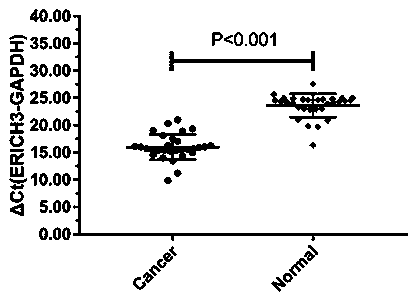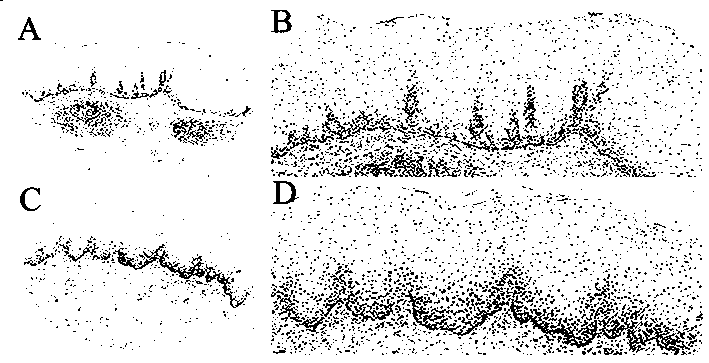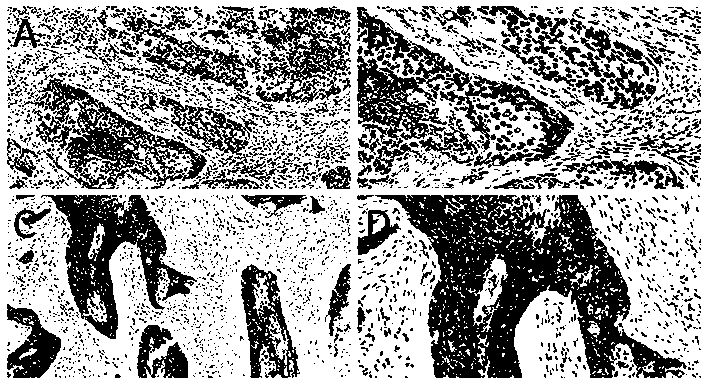Application of UGT3A2 gene and protein coded by UGT3A2 gene in auxiliary diagnosis of upper gastrointestinal tumors
A digestive tract tumor and gene technology, applied in the field of medicine and biology, can solve the problem of less molecular indicators, and achieve the effects of inducing apoptosis, promoting proliferation, and inhibiting tumor cell apoptosis.
- Summary
- Abstract
- Description
- Claims
- Application Information
AI Technical Summary
Problems solved by technology
Method used
Image
Examples
Embodiment 1
[0062] Example 1: UGT3A2 mRNA expression in esophageal squamous cell carcinoma tissue and its paired adjacent normal tissues
[0063] 1. Sample collection:
[0064] Collected 30 cases of esophageal squamous cell carcinoma patients with cancer tissue and their paired adjacent normal tissue samples. All samples were fresh specimens from esophageal squamous cell carcinoma after surgery. None of the patients received radiotherapy or chemotherapy before surgery. Surgery is the preferred treatment option. Quickly freeze in liquid nitrogen, then transfer to -80℃ ultra-low temperature refrigerator for freezing. The esophageal squamous cell carcinoma tissue used in the present invention and its paired adjacent normal tissue samples are all from the State Key Laboratory of Esophageal Cancer Prevention and Treatment jointly established by Zhengzhou University. According to the system stipulated by the ethics review committee, each patient signed an informed consent form before sampling.
[00...
Embodiment 2
[0092] Example 2: Study on the expression of UGT3A2 protein in esophageal squamous cell carcinoma tissue and its paired adjacent normal tissues
[0093] 1. Sample collection:
[0094] Collected 150 cases of esophageal squamous cell carcinoma patients' cancer tissues and their paired adjacent normal tissue samples. All samples were from paraffin tissue samples after esophageal squamous cell carcinoma surgery. None of the patients received radiotherapy or chemotherapy before surgery. Surgery is the preferred treatment option. The esophageal squamous cell carcinoma and its paired adjacent normal tissue samples used in the present invention are all from the State Key Laboratory of Esophageal Cancer Prevention and Treatment jointly established by Zhengzhou University. According to the system stipulated by the ethics review committee, each patient signed an informed consent form before sampling.
[0095] Immunohistochemical method was used to detect the expression level of UGT3A2 protein ...
Embodiment 3
[0108] Example 3: Detection of UGT3A2 protein content in serum and evaluation of its diagnostic value for esophageal squamous cell carcinoma
[0109] 1. Sample collection:
[0110] Serum samples from 60 esophageal squamous cell carcinoma patients (esophageal squamous cell carcinoma group) and 40 normal people (normal control group) from the State Key Laboratory of Esophageal Cancer Prevention and Treatment jointly established by Zhengzhou University were collected and stored at -80°C. Among them, the serum of patients with esophageal squamous cell carcinoma was collected when the patient was initially diagnosed with esophageal squamous cell carcinoma and did not receive any radiotherapy or chemotherapy. Normal human serum was the serum of healthy people who were diagnosed as having no upper digestive tumor by gastroscopy and biopsy. .
[0111] 2. Experimental method
[0112] Enzyme-linked immunosorbent assay was used to detect the content of UGT3A2 protein in serum samples of esophag...
PUM
| Property | Measurement | Unit |
|---|---|---|
| Sensitivity | aaaaa | aaaaa |
| Sensitivity | aaaaa | aaaaa |
Abstract
Description
Claims
Application Information
 Login to View More
Login to View More - R&D
- Intellectual Property
- Life Sciences
- Materials
- Tech Scout
- Unparalleled Data Quality
- Higher Quality Content
- 60% Fewer Hallucinations
Browse by: Latest US Patents, China's latest patents, Technical Efficacy Thesaurus, Application Domain, Technology Topic, Popular Technical Reports.
© 2025 PatSnap. All rights reserved.Legal|Privacy policy|Modern Slavery Act Transparency Statement|Sitemap|About US| Contact US: help@patsnap.com



